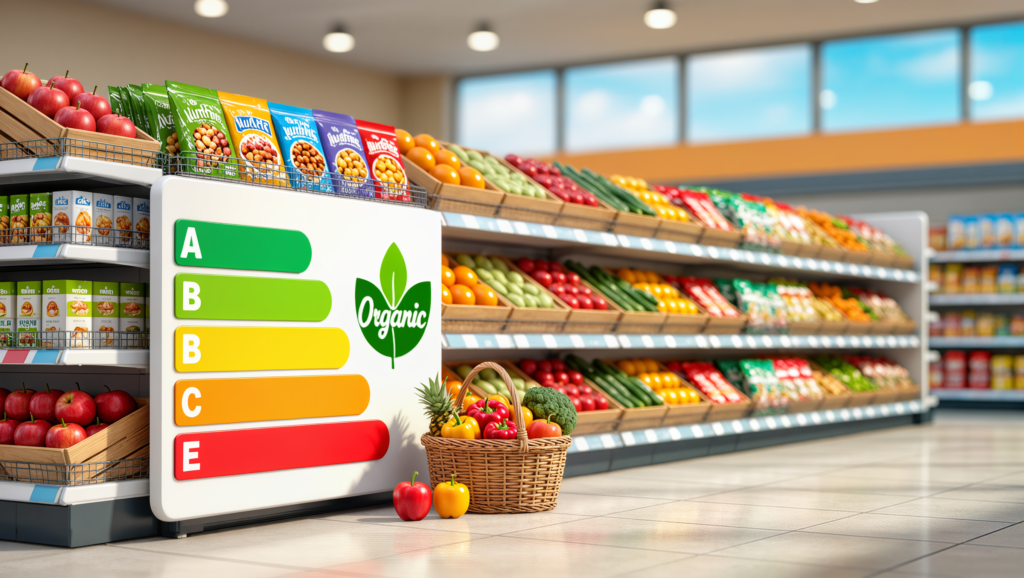Walk down any European supermarket aisle, and you’re likely hit with a sea of food labels vying for your trust. Two of the biggest—Nutri-Score and Organic—promise a shortcut to health. But which label is actually more likely to help you make a healthier choice: the color-coded Nutri-Score, rooted in nutrition science, or the green-and-white Organic badge that claims a cleaner, more natural pedigree? Let’s decode the evidence, sift through the hype, and see what each label really means for your health, even though we are obviously a pro organic food company, we will try to keep the contents of this article as neutural and unbiased as possible based on facts.
What Is Nutri-Score? Understanding the Science
Nutri-Score is a front-of-pack nutrition system that assigns a product a letter and color (A-green to E-red) based on its nutritional profile—specifically by balancing negatives (sugar, salt, saturated fat, calories) against positives (fiber, protein, fruit/veg content). Designed to let consumers quickly spot healthier options within a category (say, yogurts or breakfast cereals), Nutri-Score is now rolled out across much of Europe and strongly supported by public health officials.
- How it works: Each food’s ingredients and nutrients per 100g/ml are scored, and the total translates into an A–E grade.
- What it reveals: Nutri-Score helps you compare the nutrient density of processed foods side by side and incentivizes manufacturers to improve recipes.
- But: It does not tell you about food’s production methods, ultra-processing, presence of pesticides, or environmental impact.
What Does the Organic Label Guarantee?
The Organic label signals compliance with strict standards: no synthetic pesticides, no GMOs, restricted additives, higher animal welfare, and usually more soil-friendly and biodiversity-supporting practices. In the EU, only foods certified under defined rules can display the official “organic” leaf.
- Nutritional perks: Organic produce can have higher antioxidant levels, more certain minerals, and higher omega-3 content in meat and dairy.
- Fewer residues: Organic foods are consistently lower in pesticide residues and antibiotic-resistant bacteria.
- But: Organic does not guarantee better nutritional balance (i.e., less sugar, salt, saturated fat), nor does it stop flavored “junk” foods from being labeled organic if they’re made with certified ingredients.
Head-to-Head: Does Nutri-Score OR Organic Mean “Healthy”?
The Nutri-Score Upside
Studies show that shoppers using Nutri-Score as a guide fill their carts with products higher in fiber, lower in sugar and sodium, and generally closer to healthier dietary guidelines. In at least one large-scale, randomized trial, Nutri-Score was more effective in steering people toward nutritionally superior options than other labeling systems—especially for processed and packaged foods (think breakfast cereals, snacks, breads).
- Nutri-Score can help reduce chronic disease risk across a population if widely adopted and understood, as it consistently nudges buyers toward better overall nutrition.
- Newer Nutri-Score versions are being considered that also indicate if a product is “ultra-processed” or organic, marrying both worlds.
Where Nutri-Score Misses the Mark
Nutri-Score, critics say, has blind spots:
- It only looks at select nutritional metrics per 100g, ignoring portion size, degree of processing, food additives, and the nuance of dietary patterns.
- Unprocessed or minimally processed foods, like olive oil or traditional cheeses and fermented fish, sometimes get surprisingly poor Nutri-Scores despite their roles in healthy traditional diets.
- Nutri-Score does not measure pesticide residues, environmental footprint, nor does it factor in the “organic” status, beneficial plant polyphenols, or micronutrient variety.
The Organic Label: More Than Nutrition
Organic foods consistently show reduced levels of pesticide residues, potential for lower heavy metals, and improved environmental sustainability. Some longitudinal cohort studies suggest eating more organic foods is associated with reduced overweight/obesity risk, lower allergy rates, and even lower cancer rates—though researchers caution these are correlations, and healthier lifestyles may play a role.
- The organic effect is most pronounced for produce, meat, and dairy—where chemical inputs and farming practices matter most.
- However, certain organic foods (think cookies, pizzas, or sodas) are no better nutritionally than conventional ones, and the organic label doesn’t guarantee low sugar, fat, or sodium.
The “Organic Halo” and Consumer Perceptions
Both Nutri-Score and Organic are subject to cognitive bias:
- The organic halo effect means consumers often perceive organic snacks, desserts, and processed foods as “healthier”—even when their nutrition profile is poor.
- Shoppers using Nutri-Score may focus only on the label and ignore processing or farming practices, or “overtrust” an A-rated food that’s ultra-processed.
- Researchers recommend using both labels together—and reading ingredient lists for a full picture.
Scientific Studies: Which Label REALLY Makes You Healthier?
Nutri-Score
- Improves quality of food purchases (higher fiber, less fat and sugar) according to real-world retail data.
- Associated with lower risk of obesity, metabolic syndrome, and some chronic diseases when used regularly by shoppers.
- Has some flaws: categorizes per 100g/mL, sometimes misrepresents foods traditionally eaten in smaller or larger portions, or those with more complex health benefits.
Organic Foods
- Associated with lower pesticide and synthetic additive exposure, higher antioxidant intake, better weight management, and reduced risks of some diseases, according to multiple cohort and intervention studies.
- Health benefits are clearest when organic foods replace highly processed, pesticide-treated options—not just as an “add-on.”
When The Two Collide
An organic yogurt loaded with added sugar may get a C or D Nutri-Score—while a non-organic low-fat plain yogurt might score an A. Is one healthier? Nutri-Score captures the nutritional dimension, but not the agricultural or environmental story. The healthiest choice combines BOTH: nutrient-dense, minimally processed, organic whole foods.
The Future: Labels Are Evolving
With consumer awareness rising, Nutri-Score is being updated to factor in processing levels and maybe someday organic production. Some scientists are even calling for an all-in-one “super label” that rates foods for nutrition, sustainability, processing, and agricultural quality. Until then:
- Use Nutri-Score to compare nutrition facts among processed foods.
- Use Organic as your guide for cleaner, more environmentally friendly production.
- Choose real foods (fresh fruit, vegetables, grains, beans, meats, dairy) that are both organic and have good nutritional profiles when possible.
The Bottom Line: Which Label to Trust?
Neither Nutri-Score nor Organic is a perfect shortcut to health. Nutri-Score is an evidence-based nutrition tool—great for comparing processed products within a category but blind to farming methods and true “wholeness.” Organic ensures fewer chemicals and more eco-friendly farming but tells you little about sugar, salt, or fat.
The best path? Become a label “layerer.” Use both systems—Nutri-Score for nutrition, Organic for clean production—plus ingredient lists, minimally processed foods, and a dash of common sense. Only then do you really eat healthy for you and for the planet.
Did you find this article helpful? Support us by following us on our social media for more content on natural health and wellness:: Youtube, Instagram, Facebook, Pinterest, Twitter (X)








